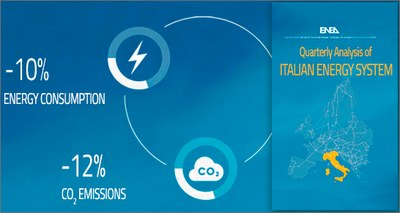Energy: ENEA analysis, in 2020 record drop in energy consumption (-10%) and CO2 emissions (-12%)
4/3/2021
Trade deficit in low carbon products and technologies increases grows to 1.1 billion euros (+60%)
Strong improvement in the ISPRED index, measuring the progress towards the energy transition (+ 38%)

2020 will be remembered as the year of a record drop in energy consumption (-10% vs 2019) and CO2 emissions (-12%), which are now 40% lower than 2005 levels. This is one of the key messages of the ENEA Quarterly analysis of the Italian energy system, which highlights as well a significant improvement (+38%) of the ISPRED index, developed by ENEA to assess the Italian energy transition by combining indicators on energy prices, energy security and decarbonisation. The analysis finds that imports of low carbon technologies increased by +27% (for a total of 2.2 billion euros), due mainly to Battery-Electric Vehicles, Plug-in Hybrid Electric Vehicles (PHEVs)and A lithium-ion batteries; taken together, these products now cover 56% of total low-carbon products imports (from 33% in 2019). Overall, the trade deficit for “green technologies” in 2020 totaled 1.1 billion euros, 60% more than in 2019; at the same time, total imports of goods decreased by 14%. Among the positive news, the trade deficit in photovoltaics disappeared, while exports PHEVs had a slight increase.
“The drop in energy consumption in 2020 is the strongest since 1943-44, during the Second World War; indeed, during the most recent crisis, that is the financial crisis of 2009, energy demand fell by just 5,7%” says Francesco Gracceva, who leads the group preparing ENEA Quarterly analysis. “60% of the drop in primary energy consumption depends on oil, as road and air traffic had a sharp fall during the year; this is why the drop in energy consumption is greater than that of GDP (-8.9%), leading to a decrease in energy intensity”, explains Gracceva. “Furthermore, CO2 emissions decreased more than energy consumption (-12% vs -10%), because the decrease in energy consumption was due mainly to fossil fuels and, among these, to the most carbon intensive ones, such as oil and coal”.
A further result of the analysis is that 30% of the decrease in CO2 emissions was due to ‘virtuous’ factors, i.e. a decrease in energy and carbon intensity, while the remaining 70% was due to the fall of economic activity (GDP).
In 2020 ENEA ISPRED index marked a remarkable increase (+38% YoY), thanks to good performances in the indicators measuring energy prices (+80%) and decarbonisation (+40%), while those related to energy security marked a slight decline, due to the difficulties in the power sector and the refining sectors facing negative margins and a sharp decline in plant utilization. "The power sector - Gracceva says – had to manage the strong increase of variable renewable generation, which reached new historical highs (20% on a monthly basis in May, over 70% on an hourly basis), and experienced a further growth in the costs of ancillary services. Furthermore, the adequacy margins were at critical low levels”.
The sharp decrease of oil and coal demand pushed the share of fossils in the energy mix to their lowest level (72%; it was 74% in 2019) since 1961, while natural gas strengthened its position as Italian main energy source (37.4% of primary energy), even though during the year gas consumption fell by 5.6% YoY. Renewables had a slight increase (+ 1% for RES electricity), while net electricity imports had a sharp fall (-13%).
“In 2020 electricity demand decreased by 5.3%, with most of the fall between March and April, during the lockdown of industrial plants, when electricity consumption lost about 30% YoY. With the gradual easing of the restrictive measures electricity demand gradually returned to the previous year’s levels: the drop was -14% YoY in the second quarter, -2.5% in the third quarter, just -0.4% in the fourth quarter, when power demand in November and December was even higher than the year before", adds Gracceva . This lead to an increase in the "electrification" of the energy system, i.e. an increase of the share of energy consumption covered by electricity, which rose to 21%, a new all-time high.
Electricity prices for non-household consumers decreased by 15% on average for all consumption bands and are now around the lows of the last decade. Electricity prices for households decreased by about 10%. As regards natural gas, prices for non-household consumers dropped by more than 20%, reaching values close to ten-year lows, especially for the largest companies. However, since the end of summer wholesale gas prices started increasing again, leading to a rapid rise in consumers’ bills in the fourth quarter, both for industrial and domestic users. A remarkable news of the year was a clear decline in the price premium traditionally paid by Italian consumers with respect to EU consumers.
Thanks to the fall in total energy consumption, the share of renewables in final energy consumption reached 20% in 2020 (+2% YoY), granting Italy to overcome its 2020 target (17%). “However, had energy consumption remained close to 2019 levels, the share of RES would have been limited to about 18%, like in 2019. This is a confirmation of the slow progress towards the 2030 target (30%). Indeed, 2020 marked a slowdown in the trend of new installations of renewable power capacity, which are growing much slower than requested to reach the 2030 target”, Gracceva says.
The whole analysis and synopsis are available at: https://www.enea.it/it/seguici/pubblicazioni/analisi-trimestrale-del-sistema-energetico-italiano/
